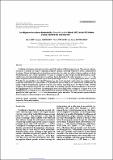Por favor, use este identificador para citar o enlazar a este item:
http://hdl.handle.net/10261/184854COMPARTIR / EXPORTAR:
 SHARE SHARE
 CORE
BASE CORE
BASE
|
|
| Visualizar otros formatos: MARC | Dublin Core | RDF | ORE | MODS | METS | DIDL | DATACITE | |

| Título: | Coralligenous formations dominated by Eunicella cavolini (Koch, 1887) in the NE Mediterranean: biodiversity and structure |
Autor: | Sini, Maria; Garrabou, Joaquim CSIC ORCID ; Trygonis, Vasilis; Koutsoubas, D. | Palabras clave: | Mediterranean Benthic communities Photoquadrat sampling Aegean Sea Coralligenous Conservation Biodiversity Eunicella cavolini Gorgonians |
Fecha de publicación: | abr-2019 | Editor: | Hellenic Centre for Marine Research | Citación: | Mediterranean Marine Science 20(1): 174-188 (2019) | Resumen: | Coralligenous formations are biogenic structures typical of the underwater Mediterranean seascape. Their intricate, multi-layered species assemblages are composed of perennial, long-lived organisms, particularly vulnerable to natural or human-induced disturbances. Despite their high ecological role and conservation value, few studies have addressed the assemblages outside the NW Mediterranean. This is the first quantitative assessment of coralligenous in the N Aegean Sea (NE Mediterranean), specifically focusing at the upper bathymetric limit of assemblages that are dominated by the yellow gorgonian Eunicella cavolini. The number and percent cover of macrobenthic species were studied at depths of 18 to 35 m, using a photoquadrat method. A total of 99 benthic taxa were identified, out of which 89 perennial ones were used to investigate spatial patterns in assemblage structure, composition, and biodiversity. A mean number of 47 perennial taxa were recorded per site, with encrusting coralline algae and sponges being the dominant groups in percent cover and species number, respectively. Across the studied localities, structural complexity and community composition were overall similar, but assemblages presented distinctive differences at the level of sites highlighting the role of local abiotic and anthropogenic factors in the shaping of the coralligenous. Compared to the rest of the Mediterranean, assemblages hosted a similar number of taxa. However, the number and percent cover of erect bryozoans were generally low, while, apart from E. cavolini, other erect anthozoan species were absent. This work provides an important baseline for comparisons and monitoring at a local or Mediterranean scale level | Descripción: | 15 pages, 6 figures, 4 tables | Versión del editor: | https://dx.doi.org/10.12681/mms.18590 | URI: | http://hdl.handle.net/10261/184854 | DOI: | 10.12681/mms.18590 | Identificadores: | doi: 10.12681/mms.18590 issn: 1108-393X e-issn: 1791-6763 |
| Aparece en las colecciones: | (ICM) Artículos |
Ficheros en este ítem:
| Fichero | Descripción | Tamaño | Formato | |
|---|---|---|---|---|
| Sini_et_al_2019.pdf | 1,27 MB | Adobe PDF |  Visualizar/Abrir |
CORE Recommender
SCOPUSTM
Citations
13
checked on 12-abr-2024
WEB OF SCIENCETM
Citations
11
checked on 21-feb-2024
Page view(s)
256
checked on 17-abr-2024
Download(s)
220
checked on 17-abr-2024
Google ScholarTM
Check
Altmetric
Altmetric
Este item está licenciado bajo una Licencia Creative Commons



